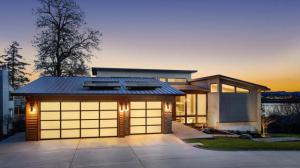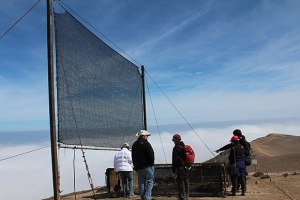
Source’s hydropanel in a rooftop application.
Atmospheric water generation (AWG) uses technology to produce potable water from the surrounding air. Drinking water supplies around the world are endangered as populations increase, groundwater is depleted and surface supplies shrink. Oceans could be tapped, but desalination is energy intensive and costly. There are, however, approximately 3,100 cubic miles of water vapor in the atmosphere, a nearly unlimited resource continuously replenished by the planet’s hydrologic cycle, so taking water from the air will not harm the environment. Atmospheric water generators (AWG) are now being developed to squeeze water from the air.
AWG generators range from home-based units that can produce 5 gallon of water per day to commercial-scale units capable of 250 to over 2,500 gallons per day. Water production rates are highly dependent upon the air temperature and the amount of water vapor (i.e., humidity) in the air. Although the most commonly used AWG systems are energy-intensive, employing condenser and cooling coil technology to pull moisture from the air, AWG technologies continue to advance, often using renewable energy to extract clean and purified water in surprisingly high quantities.
Here are seven innovative advances in AWG systems that go beyond current energy-intensive technologies and aim to provide condensed drinking water for water-impoverished regions around the world.
Hydropanels
Source, based in Arizona, uses solar energy to power hydropanels that are completely off-grid. Solar-powered fans pull in ambient air and capture the water vapor in a hygroscopic (water-absorbing) material. The water vapor is then extracted and passively condensed into liquid water, which is then sterilized with a built-in ozone generator.

Fog collection in Alto Patache, Atacama Desert, Chile
Fog Collection
Fog collection is the harvesting of water from fog using large pieces of vertical mesh netting to induce the fog-droplets to flow into a trough below. Known as a fog fence, fog collector or fog net, through condensation atmospheric water vapor condenses on on the fabric into droplets of liquid water. As the exposed surface cools by radiating its heat to the sky, atmospheric moisture condenses at a rate greater than that of which it can evaporate, resulting in the formation of water droplets.
Gel Film Technology
Researchers at the University of Texas, Austin, have developed an inexpensive gel-film material that can extract 1-2 gallons of water from the air per day. The material consists of cellulose and konjac gum, whose open pore structure accelerates the moisture-capturing process. A slight heating of the cellulose releases the captured water.
Zeolite
Massachusetts Institute of Technology scientists are developing an AWG system that uses an absorbing mineral compound called zeolite to collect water vapor from the air at night. By day, heat generated from a solar collector plate releases the water from the material. Zeolite being highly porous, it’s capable of producing significant amounts of water from air with a relative humidity as low as 20 percent.
Nanotechnology
Massachusetts Institute of Technology scientists are developing an AWG system that uses an absorbing mineral compound called zeolite to collect water vapor from the air at night. By day, heat generated from a solar collector plate releases the water from the material. Zeolite being highly porous, it’s capable of producing significant amounts of water from air with a relative humidity as low as 20 percent.
 The WEDEW System
The WEDEW System
Wood-to-Energy Deployable Water (WEDEW) is an innovative AWG generating 500 gallons of water or more per day from organic waste material. Plant or animal waste is placed in a shipping container, where a humid environment produces biogas through decomposition. This decomposition releases water vapor, which is trapped in the container and then extracted.
Fontus Airo
Powered by a small solar-powered rechargeable battery, Fontus Airo is a self-refilling water bottle that takes less than an hour to fill itself using built-in AWG technology. Air drawn into the device flows across hydrophobic bristles, condensing its water vapor into water droplets. One bottle can produce about one pint of water per hour.
More About Hydropanels
The Source hydropanel uses solar power to run the panels entirely off the grid. Sunlight hits the hydropanel powering the internal fans, drawing in the ambient air. From here, the air is pulled or pushed through hygroscopic material. This “water-loving” material can absorb the moisture (water vapor) from the air and then condense on the surface of a cold plate inside the hydropanel. The collected water passes through a mineralizing cartridge in the reservoir, then passes through an activated carbon polishing cartridge where it is filtered, sterilized, and then mineralized before being dispensed at the tap. A standard array consisting of two hydropanels can produce between 1 – 2.5 gallons of clean water per day, depending on ambient humidity levels.
Conclusion
Condensing water from the atmosphere will be one of the most important innovations in the coming years as freshwater becomes more scarce/controlled due to overpopulation, government policies, geopolitics, and climate change. It has been estimated that nearly 90 countries will be facing severe water shortages by 2050.
Therefore, demand for AWG is understandably high, with the value of the AWG market expected to grow by about $4 billion from 2020 to 2025. AWG systems can provide an off-grid, reliable water supply, reduce the use of plastic in water bottles, and reduce the need for expensive water infrastructure.
For Further Reading:
• The patented SOURCE hydropanel system is described at their website, https://www.source.co/.
• Wood-to-Energy Deployable Emergency Water (WEDEW) is presented at their site, https://www.skysource.org/wedew.
• The personal Fontus Airo device can be found at https://fontus.at/products/.
